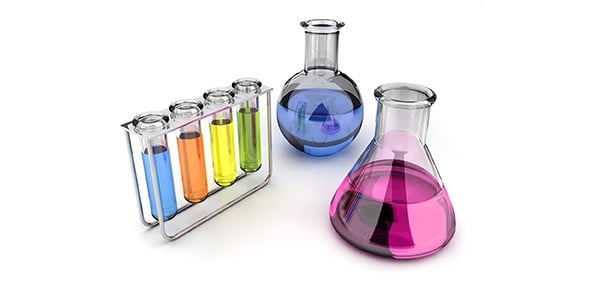Part B Exothermic Or Endothermic Reactions

This quiz titled 'Part B Exothermic or Endothermic reactions' assesses understanding of reaction energetics. It includes determining whether reactions are exothermic or endothermic based on enthalpy changes, enhancing skills in thermodynamics relevant to educational and professional chemistry studies.
- 1.
C6H12O6 + 6O2 --> 6CO2 + 6H2O ∆H = -2803 kJ
- A.
Exothermic
- B.
Endothermic
Correct Answer
A. ExothermicExplanation
The given chemical equation represents the process of cellular respiration, where glucose (C6H12O6) is oxidized to produce carbon dioxide (CO2) and water (H2O) with the release of energy. The negative value of ΔH (-2803 kJ) indicates that the reaction releases energy to the surroundings, making it exothermic.Rate this question:
-
- 2.
6CO2 + 6H2O --> C6H12O6 + 6O2 ∆H = +2803 kJ
- A.
Exothermic
- B.
Endothermic
Correct Answer
B. EndothermicExplanation
The given chemical equation represents the process of photosynthesis, where carbon dioxide and water are converted into glucose and oxygen with the help of sunlight. The positive value of ΔH (+2803 kJ) indicates that energy is absorbed or taken in during this reaction. Since an endothermic reaction is characterized by the absorption of heat or energy from the surroundings, the given reaction is endothermic.Rate this question:
-
- 3.
3NO2 + H2O --> 2HNO3 + NO ∆H = - 138 kJ
- A.
Exothermic
- B.
Endothermic
Correct Answer
A. ExothermicExplanation
The given reaction is exothermic because it releases heat energy. This is indicated by the negative value of ΔH, which is -138 kJ. In an exothermic reaction, the products have lower energy than the reactants, and the excess energy is released as heat.Rate this question:
-
- 4.
C + H2O --> CO + H2 ∆H = + 113 kJ
- A.
Exothermic
- B.
Endothermic
Correct Answer
A. ExothermicExplanation
The given chemical reaction releases heat energy, as indicated by the positive value of ∆H (113 kJ). This means that the reaction is exothermic. In an exothermic reaction, the products have lower energy than the reactants, and the excess energy is released as heat.Rate this question:
-
- 5.
CH4 + 2 O2 --> CO2 + 2 H20 + 213.2 KJ
- A.
Exothermic
- B.
Endothermic
Correct Answer
A. ExothermicExplanation
The given chemical reaction is exothermic because it releases energy in the form of heat. This is indicated by the positive value of 213.2 KJ, which represents the heat released during the reaction. In an exothermic reaction, the products have lower energy than the reactants, resulting in the release of energy.Rate this question:
-
- 6.
N2(g) + O2(g) + 43 kcal -----> 2 NO(g)
- A.
Exothermic
- B.
Endothermic
Correct Answer
B. EndothermicExplanation
The given reaction is endothermic because it requires energy in the form of heat to proceed. This is indicated by the positive value of 43 kcal, which represents the heat absorbed during the reaction. In an endothermic reaction, the reactants have lower energy than the products, and energy is absorbed from the surroundings to make up the difference.Rate this question:
-
- 7.
- A.
Exothermic
- B.
Endothermic
Correct Answer
B. Endothermic -
- 8.
C3H8(g) + 5 O2(g) -----> 3 CO2(g) + 4H2O(g) + 2200 kJ
- A.
Exothermic
- B.
Endothermic
Correct Answer
A. ExothermicExplanation
The given chemical equation represents the combustion of propane (C3H8) in the presence of oxygen (O2) to produce carbon dioxide (CO2) and water (H2O). The release of 2200 kJ of energy indicates that this reaction is exothermic. In an exothermic reaction, energy is released in the form of heat, making the surroundings warmer.Rate this question:
-
- 9.
- A.
Exothermic
- B.
Endothermic
Correct Answer
A. Exothermic -
- 10.
If a reaction finishes with more energy than it started, it must be a
- A.
Exothermic
- B.
Endothermic
Correct Answer
A. ExothermicExplanation
If a reaction finishes with more energy than it started, it must be an exothermic reaction. In an exothermic reaction, energy is released to the surroundings, resulting in a decrease in the overall energy of the system. This means that the final energy of the reaction products is lower than the initial energy of the reactants. Therefore, if the reaction finishes with more energy than it started, it indicates that energy has been released, making it an exothermic reaction.Rate this question:
-
Quiz Review Timeline +
Our quizzes are rigorously reviewed, monitored and continuously updated by our expert board to maintain accuracy, relevance, and timeliness.
-
Current Version
-
Mar 21, 2023Quiz Edited by
ProProfs Editorial Team -
Sep 17, 2017Quiz Created by
Yasmin Sarmiento




